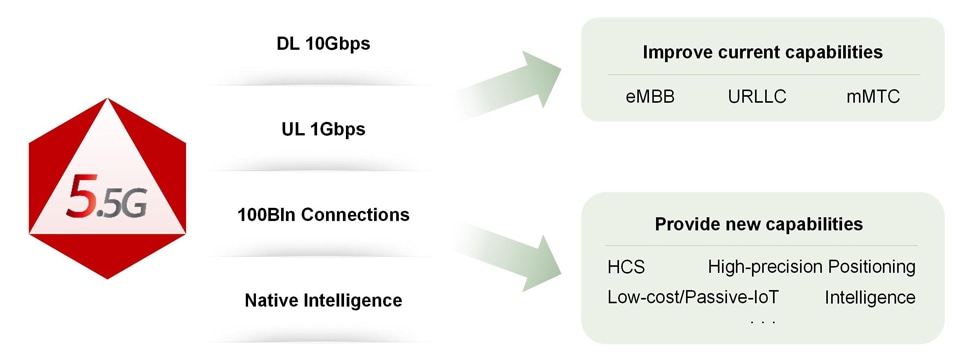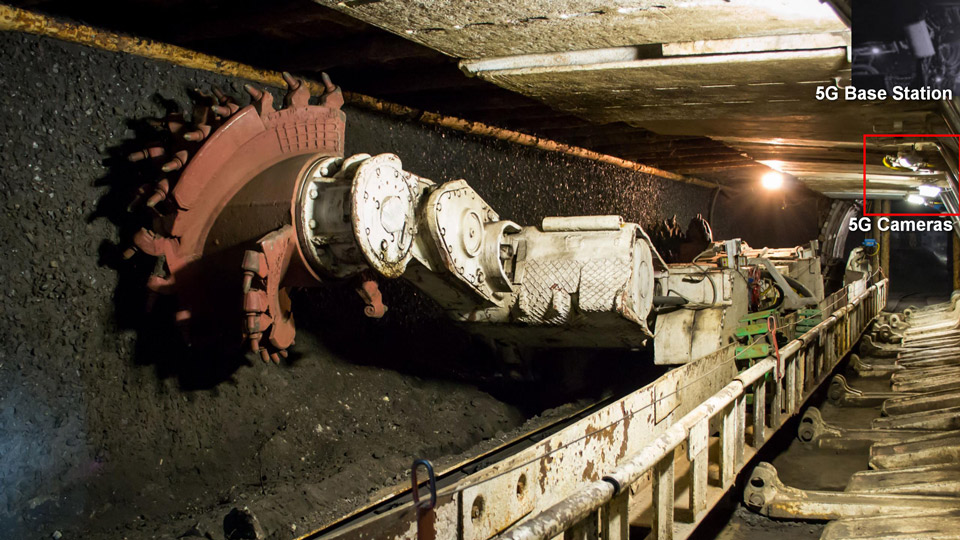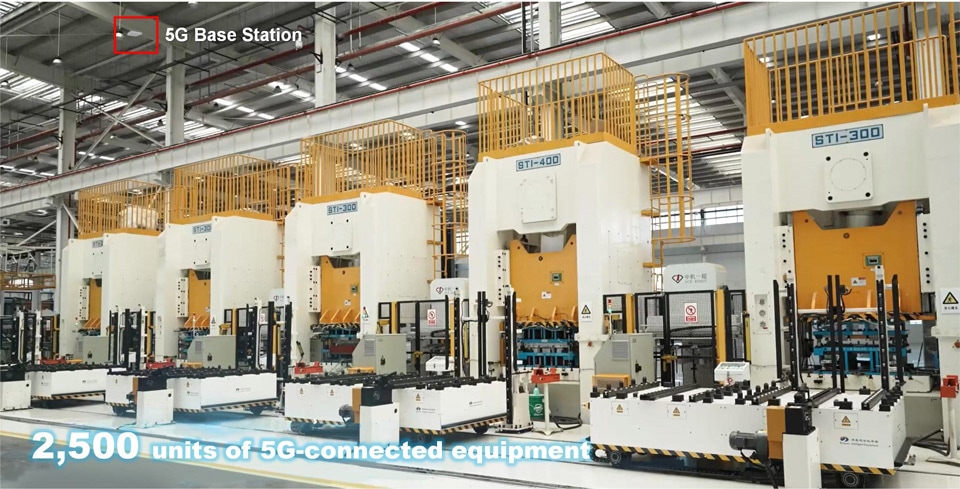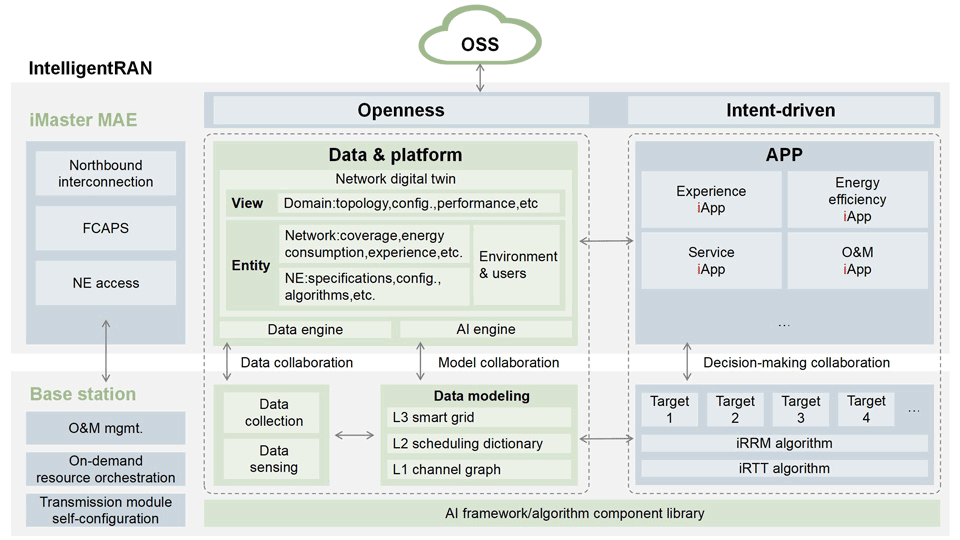New Solutions
Striding to 5.5G: From IoE to Intelligent IoE
Coordinated industry-wide efforts have created a positive development cycle for networks, users, devices, and services, laying the foundation for 5.5G.


By Cao Ming, President, Wireless Network Product Line, Huawei

Technology creates value, and innovation is the main engine of future development. 5G has already become a key part of the infrastructure needed to support digital transformation and the healthy development of the wider digital economy. Since its commercial rollout three years ago, 5G has grown faster than any previous generation of mobile technology. By the end of 2022, more than 240 carriers around the world had launched commercial 5G services and deployed more than three million 5G sites to serve one billion 5G users.
5G is advancing twice as fast as 4G, and already boasts a mature industry ecosystem. It is already bringing about change, but this is merely the beginning. As we inch closer to the intelligent world, new changes, scenarios, and needs will continue to emerge, raising higher requirements on network infrastructure. 5G is now able to deliver Gbit/s-level experiences and support tens of billions of connections, making it an important pillar for sustainable development and the global digital economy. 5.5G will deliver 10-fold higher network capabilities, enabling 10 Gbit/s experiences, 100 billion connections, and native intelligence for a broad diversity of services. This makes 5.5G an important milestone on the path to an intelligent world.

Figure 1: Key characteristics of 5.5G networks
Gigabit to 10 gigabit: 10x better connectivity experience for users
5G is changing how people watch video, allowing them to enjoy a superior experience. HD and interactive videos have become popular services among users. The number of panoramic videos and videos that support skipping and variable-speed playback is increasing rapidly. With 5G, the proportion of HD mobile videos increased to 60%, from 4G's 40%. Better user experience leads to a tangible increase in DoU and stimulates tariff plan upgrades, benefiting both users and carriers. In countries and regions that have seen rapid 5G development, such as China, South Korea, and Kuwait, carriers have invested heavily in 5G and maximized its value by offering outstanding experiences. As a result, carrier revenue and profits in these countries have grown significantly faster than the global average.

Figure 2: 5G changed how personal applications are used
Innovative services such as XR have also become a driving force behind 5GtoC development. The large-scale deployment of XR services requires synergies between 5G networks, cloud, and devices. The ultra-large broadband and low latency delivered by 5G networks are essential for the real-time rendering and 3D reconstruction commonly used in XR services. In the future, applications like XR Pro and metaverse will significantly blur the lines between the virtual world and real world, creating a digital mirror of the real world. Users will be able to explore the real world through simulated experiences powered by advanced computing and haptic feedback technologies. These kinds of real-time immersive interactive applications require 10 Gbit/s mobile networks and millisecond-level transmission latency.
Ultra-large bandwidth spectrum is essential for upgrading from 5G's gigabit networks to 5.5G's 10 gigabit networks. To guarantee spectrum resources for 5.5G, we need to make the most of sub-100 GHz spectrum and open up more high-frequency and large-bandwidth spectrum, such as 6 GHz and millimeter wave. We also need to change how the sub-6 GHz spectrum is used to achieve ultra-large bandwidth. Extremely large aperture array (ELAA) technologies can help address coverage issues in high bands and allow them to achieve coverage as large as C-band, making 10 Gbit/s possible anytime, anywhere.
5G2B applications: Deployment in core production activities will unleash the potential of 100 billion IoT connections
After three years of 5G2B development, 5G is being applied at scale in multiple industries, including mining, ports, and healthcare. Underground coal mines (as shown in Figure 3) are now seeing more than 100 HD cameras, a large number of sensors, and workers deployed and connected using 5G networks, enabling workers to complete 60% of underground work safely from an office above ground. One fully-connected 5G factory (as shown in Figure 4) has used 5G in 15 production processes to connect more than 2,500 units of production equipment, significantly improving the factory's production efficiency.
Chinese carriers are already making 5GtoB a new engine for revenue growth. In 2022, 5GtoB enabled carriers to generate more than US$20 billion in DICT revenue, making it the fastest growing service domain for carriers. 5GtoB is also expected to see its revenue exceed US$30 billion while contributing hundreds of billions in DICT revenue by 2025.

Figure 3: 5G coal mine

Figure 4: Fully-connected 5G factory
5.5G will be able to meet the increasing needs of industry digitalization. As 5G moves beyond just assisting production to becoming an integral part of key production activities, networks will need to provide new capabilities such as high-speed uplink transmission and high-precision positioning. In particular, as services such as machine vision and remote control require high uplink rates to upload multi-channel UHD videos in real time, high-speed uplink transmission has become a must-have for 5G2B industry applications.
The industry is already exploring new methods of improving 5G uplink capabilities. Uplink and downlink decoupling technologies, for example, reconstruct spectrum usage models, allowing for the multi-band convergence of uplink and downlink spectrum on different bands. This enables existing FDD spectrum and uplink-only spectrum to be fully used to provide Gbit/s-level uplink rates.
Many industries have extensively explored IoT, but have so far failed to achieve economies of scale due to fragmentation in existing connectivity technologies. Nevertheless, the economies of scale being seen in the mobile industry can help three 5G-centered IoT technologies deliver business success: Reduced Capability (RedCap), Narrowband IoT (NB-IoT), and passive IoT. NB-IoT is currently the mainstream low-power wide-area (LPWA) network technology, and is rapidly gaining momentum. RedCap is also ready for commercial use, is cheaper and consumes less power than eMBB, and has the potential to create billions of medium- and high-speed connections. Passive IoT combines cellular communications and passive tagging, enabling long-distance coverage with low-cost terminals. It is expected to facilitate the connection of tens of billions of passive IoT devices. Wireless networks will boast integrated communication and sensing. The use of mmWave can increase sensing accuracy and thus facilitate new applications, such as speed and distance measurements and imaging.
Intelligence is key to addressing growing network complexity
Any carrier seeking to tap into the new markets and business models created by 5G and 5.5G and pursue digital and intelligent transformation will need to integrate intelligence into wireless network services, experience, O&M, and green development. Many carriers outside of China have proposed intelligent transformation strategies to build intelligent capabilities for simplified O&M, superior performance, and an ultimate experience. One Chinese carrier has proposed an autonomous network strategy, aiming to achieve network-wide L4 autonomous driving networks by 2025.

Figure 5: Intelligent architecture for mobile networks
The expected exponential increase in network complexity will also drive networks to become intelligent. A natively intelligent architecture (see Figure 5) enables mobile networks to support real-time sensing, modeling and prediction, and multidimensional decision-making. With these intelligent capabilities, mobile networks will be intelligently optimized with resources that can be configured on demand for optimal user experience and capacity. O&M will also be intelligently simplified by automated site planning, deployment, and troubleshooting. Significant energy savings can then also be intelligently achieved while maximizing network performance.
Green ICT: Addressing a hundred-fold increase in traffic with only a slight increase in energy consumption
Industries today are focusing on achieving green and sustainable development. The mobile industry is no exception. With the introduction of technologies such as Massive MIMO, 5G has greatly reduced power consumption per bit and is able to transmit ten times more data than 4G for each watt consumed.
Network traffic will continue growing rapidly, with DoU projected to reach 600 GB by 2030. This has prompted the mobile industry to develop innovative technologies for high-performance, energy-efficient networks that can address a hundred-fold increase in traffic with only a slight increase in energy consumption.
Huawei has proposed an architecture for improving network efficiency across three different layers: equipment, sites, and networks (see Figure 6). Our innovation in system architecture, materials, and heat dissipation technology has led to increased equipment integration. At the site level, in addition to single site simplification, we now support intelligent coordination between whole-site facilities. And at the overall network level, we are using AI to perform dynamic, real-time optimization, laying a technical foundation for green 5G networks.

Figure 6: Three-layer (device-site-network) architecture for energy-saving
At the 2020 Global Mobile Broadband Forum (MBBF), Huawei launched its 5.5G industry vision, and defined three new scenarios that build on the original three 5G scenarios of eMBB, mMTC, and URLLC. These three new scenarios are Uplink Centric Broadband Communication (UCBC), Real-Time Broadband Communication (RTBC), and Harmonized Communication and Sensing (HCS).
They will enable evolution from IoE to intelligent IoE.
After two years of concerted efforts across the industry, 5.5G has seen huge progress and three things have become clear. First, the standardization of 5.5G is already underway and right on track. Second, the industry has made breakthroughs in key technologies for 5.5G, and ultra-large bandwidth and ELAA can now deliver a 10-Gbit/s experience. Third, the industry has a clear vision for the IoT landscape. The three types of IoT technologies supported by 5.5G — NB-IoT, RedCap, and passive IoT — are developing rapidly and will support numerous IoT connections.
At the new stage for 5.5G, the industry needs to prepare well in five areas: standards, spectrum, products, ecosystems, and applications. First, we need to continue setting standards and promoting key technological research. Second, we need to prepare more spectrum. For example, we should fully utilize sub-100 GHz resources to build ultra-large bandwidth. Third, we need to prepare for 5.5G with mature networks, devices, and chips. Both our networks and devices need to be upgraded to deliver a 10 Gbit/s experience. Fourth, the industry needs to coordinate to plan and prepare for different scenarios for a thriving 5.5G ecosystem. Fifth, all players across the industry need to collaboratively explore how to pave the way for more diverse applications to emerge.
An industry-wide consensus has been reached on the vision, standards, and technologies that will underpin 5.5G. Moving forward, we will need to continuously strengthen technological innovation and collaborate with ecosystem partners to pave the way for the commercialization of 5.5G.
So, the wind is rising and it is time to set sail. Huawei is passionate about working with global carriers and industry partners to create a 5.5G that has significant business value. I have no doubt that it will soon serve as a benchmark we can use to move towards an intelligent world.
- Tags:
- 5.5G





